A well-designed kitchen blends simplicity with practicality. Many homeowners want a clean, clutter-free space but worry about sacrificing usability. The truth? A minimalist kitchen can be both stylish and fully functional.
One family transformed their cooking area over three years by following the “Rule of Three.” They kept only essential dishware, stored rarely used items away, and focused on design that promotes calm. The result? Less stress and more enjoyment during meal prep.
Whether you love baking or brewing coffee, a streamlined setup adapts to your needs. Start with a 30-day “Project Simplicity” challenge to declutter appliances and prioritize what truly matters. Clear counters and intentional storage make daily tasks easier.
Key Takeaways
- Balance clean aesthetics with everyday functionality
- Use the “Rule of Three” to limit dishware without losing hosting capabilities
- Decluttering reduces stress and improves workflow
- Adapt minimalist principles for baking, cooking, or coffee routines
- Structured challenges help build long-term habits
What Does a Minimalist Kitchen Look Like?
A pared-back kitchen isn’t sterile—it’s where your grandmother’s mixing bowl meets modern efficiency. Sunlight dances across open shelves holding Mason jars of lentils, while a single cast-iron skillet hangs beside the stove. This space breathes.
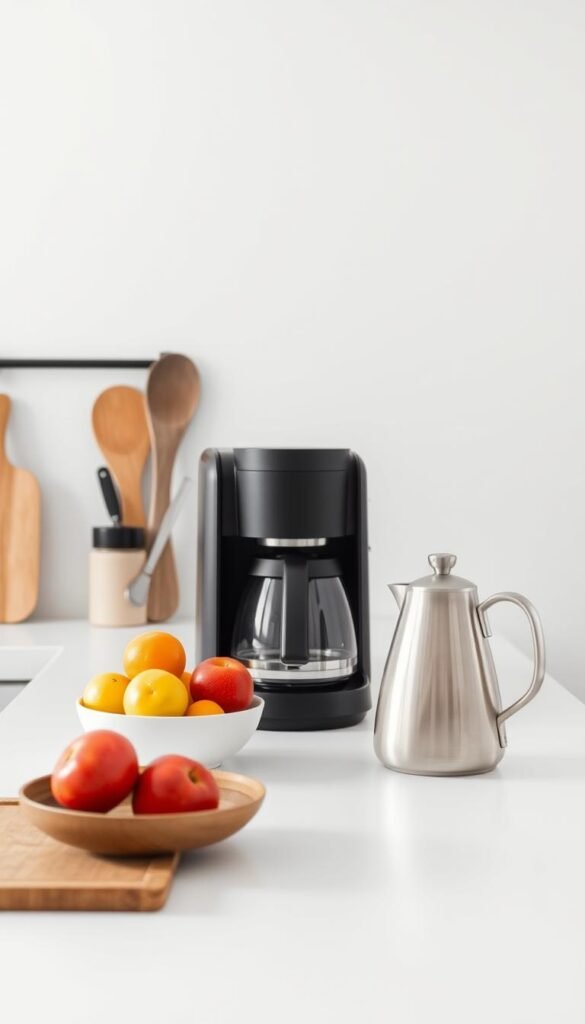
Defining Minimalism in the Kitchen
True minimalism means curated essentials, not emptiness. It’s:
- Keeping heirloom glassware but donating chipped mugs
- Choosing one premium chef’s knife over a block of unused gadgets
- Storing bulk goods in clear containers for visual calm
As seen in minimalist home decor, cohesion comes from intentionality—not matchy-matchy sets.
Common Misconceptions About Minimalist Kitchens
Many assume these spaces forbid personality. Not so:
- Coffee stations stay: A sleek espresso machine can align with simplicity if used daily
- Visible items aren’t clutter: That well-worn cookbook? It sparks joy weekly
- Mismatched dishes work: Group white plates with handmade pottery for eclectic harmony
The goal? A functional kitchen that soothes rather than overwhelms. Start by removing duplicates—not treasures.
How to Achieve a Minimalist Kitchen Without Losing Functionality
Transforming your cooking space into a functional yet serene environment begins with mindful choices. Focus on keeping essentials that align with your daily habits—like a chef’s knife or a trusty skillet—while letting go of excess that gathers dust.
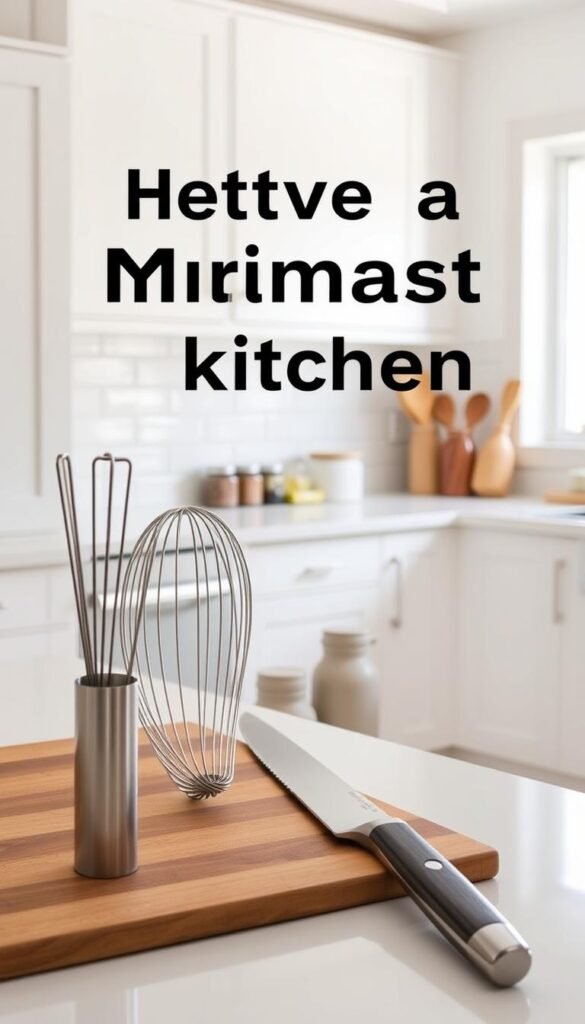
Start with Decluttering: The First Step
Try the “Three-Touch” technique for sentimental pieces: Hold the item three times. If it doesn’t spark joy or serve a purpose by the third touch, thank it and donate. Wedding china displayed in a cabinet? Keep it. Chipped mugs from a 2005 conference? Release them.
For appliances, apply the “90-Day Test”. If you haven’t used that waffle maker in three months, store it elsewhere or pass it on. This method reveals what you truly use versus what you think you need.
Keep Only What You Use and Love
Build a “kitchen resume” to identify your real cooking habits. Do you bake weekly? Keep the stand mixer. Prefer quick stir-fries? Prioritize a wok over specialty pans. One homeowner replaced seven spatulas with one multi-use fish turner—now their drawers close effortlessly.
Adopt the “Rule of Three” for Dishes and Utensils
Limit dishware to three of each essential: plates, bowls, and mugs. Store them where you reach daily—like nested stoneware beside morning vitamins. This curbs excess while ensuring hosting capability (wash between guests).
- Forks & knives: Keep 4–6 settings to balance daily use and gatherings
- Mixing bowls: One small, medium, and large covers most tasks
- Glasses: Three versatile tumblers replace a cabinet of mismatched cups
Smart Storage Solutions for a Minimalist Kitchen
The secret to an uncluttered cooking area lies in strategic organization. With the right approach, even the tiniest kitchen can feel spacious. Focus on solutions that blend form and function—like Mason jars for grains or under-shelf racks for cookbooks.
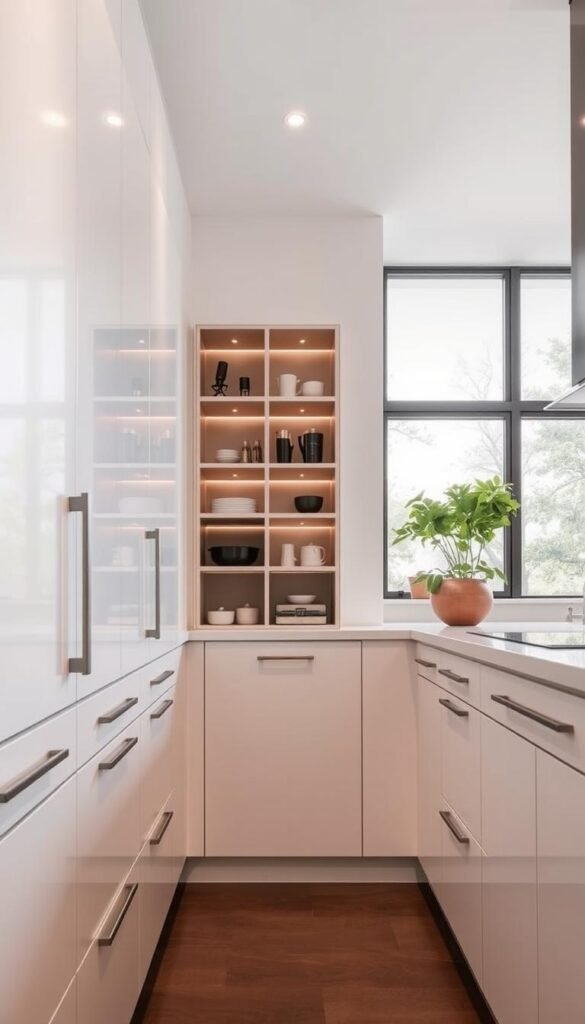
Maximizing Cabinet and Drawer Space
Awkward corners become usable with tension rods for spices. Pegboards transform walls into storage hubs for copper pots. Fold linens the KonMari way—neat stacks with texture contrasts make drawers serene.
Lazy Susans repurpose dead zones. One homeowner turned a blender graveyard into a spinning appliance station. The trick? Prioritize daily-use items at eye level.
Using Vertical Storage Effectively
Plate racks aren’t just for dishes. Mount them vertically to organize baking sheets. Magnetic strips hold knives—and dry herbs when hung near sunlight.
Stackable bins in the fridge group like items. Clear containers reveal pantry staples at a glance. Vertical storage saves space while keeping essentials accessible.
The Power of Multi-Functional Items
A fish turner flips pancakes and serves pasta. Nesting bowls shrink to fit tight cabinets. Choose tools that pull double duty, like a colander that doubles as a fruit bowl.
Every piece should earn its spot. If it doesn’t serve at least two purposes, reconsider its place in your design. Multi-functional items cut clutter without sacrificing utility.
Minimalist Kitchen Design Principles
The heart of a minimalist kitchen lies in its design—where every element serves a purpose. From the calming palette to the strategic placement of appliances, simplicity becomes a lifestyle. Here’s how to craft a space that feels both serene and fully functional.
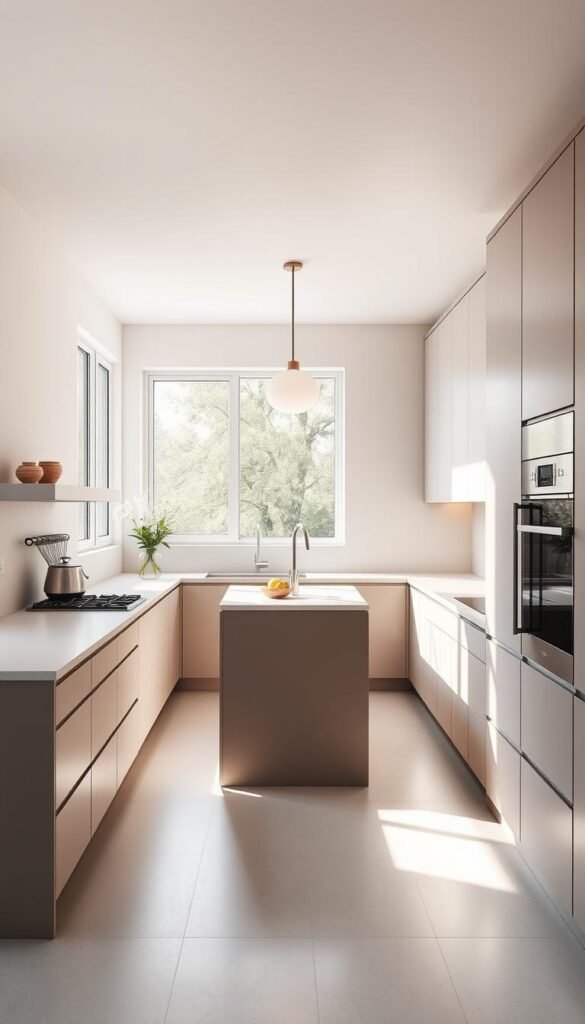
Neutral Tones and Clean Lines
Start with a foundation of soft whites, warm grays, or earthy taupes. These neutral tones create timeless appeal and amplify natural light. Pair them with uncluttered lines—think flat-panel cabinets and sleek hardware.
Matte black faucets against a Carrara marble backsplash add depth without visual noise. The contrast feels intentional, not chaotic. This approach mirrors the psychology of calm spaces—where every detail contributes to harmony.
Keeping Countertops Clear
Resist the urge to crowd surfaces. Only essentials like a knife block or daily coffee maker deserve permanent spots. Open space invites creativity—and makes wiping spills effortless.
Appliance garages hide blenders or toasters behind sliding panels. Compare this to cluttered “everything out” kitchens. The difference? One sparks stress; the other fosters focus.
Choosing the Right Appliances
Prioritize quality over quantity. A stainless steel toaster that complements hammered copper canisters blends style and utility. Integrated refrigerators save space in small kitchens, while freestanding models offer flexibility.
Under-cabinet lighting isn’t just practical—it transforms midnight snack rituals into cozy moments. Every choice should enhance both design and daily life.
Decluttering Your Kitchen Appliances
The hum of a well-used blender tells a different story than the silence of a forgotten waffle maker. Appliances should simplify cooking—not crowd countertops. Start by evaluating which gadgets truly serve your daily routines.
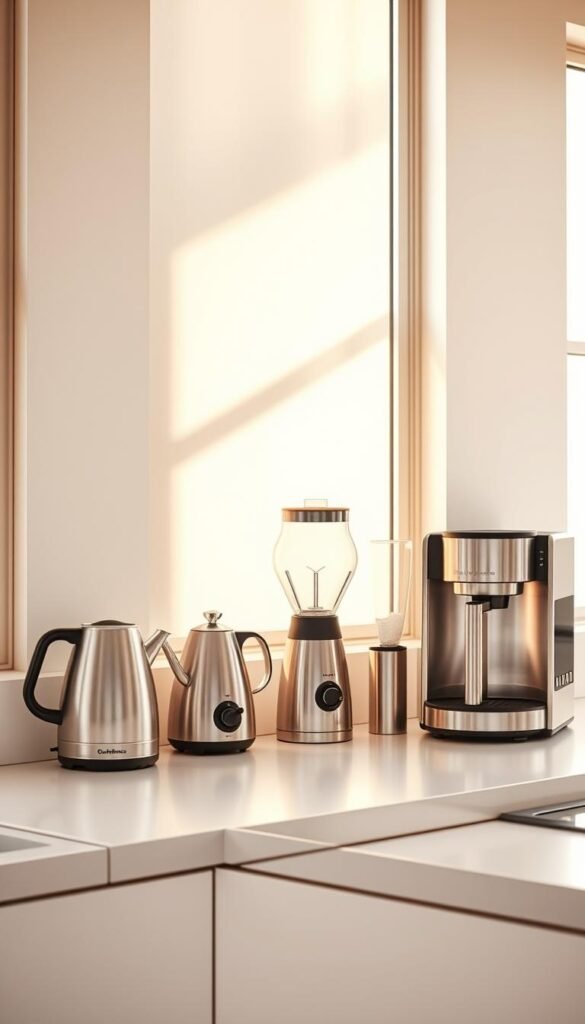
Assessing What You Really Need
Calculate the “cost per use” for each item. That panini press at $3.71 per sandwich? It might belong in a thrift store. Keep a mental log: if you haven’t touched the rice cooker in three months, it’s likely excess.
One homeowner replaced plastic containers with Pyrex—clear, stackable, and oven-safe. The switch saved cabinet space and reduced clutter. Ask: “Does this appliance align with my cooking habits?”
Letting Go of Single-Use Gadgets
Create playful “appliance obituaries” to ease goodbyes. Example: “Beloved juicer, 2015–2017, made 14 carrot juices.” This reframes decluttering as honoring purpose, not guilt.
Prioritize multi-taskers. A food processor that slices, dices, and kneads dough? Worth its spot. A avocado slicer used twice a year? Donate it.
Storing Appliances Out of Sight
Repurpose a china cabinet as an appliance gallery—store the stand mixer behind glass doors with intentional lighting. Seasonal tools like holiday cookie presses can take “vacations” in attic bins.
Use vintage bread boxes to hide toasters or blenders. The key? Designate zones. A coffee station stays accessible; the waffle iron tucks away until Sunday brunch.
Every appliance should earn its space. When in doubt, apply the 90-day test. Your kitchen will thank you.
Organizing Pots, Pans, and Bakeware
Quality bakeware deserves storage as intentional as its craftsmanship. Whether you’re simmering sauces or baking bread, the right cooking tools should be accessible—not buried. Thoughtful organization turns chaotic cabinets into curated collections where every piece has purpose.
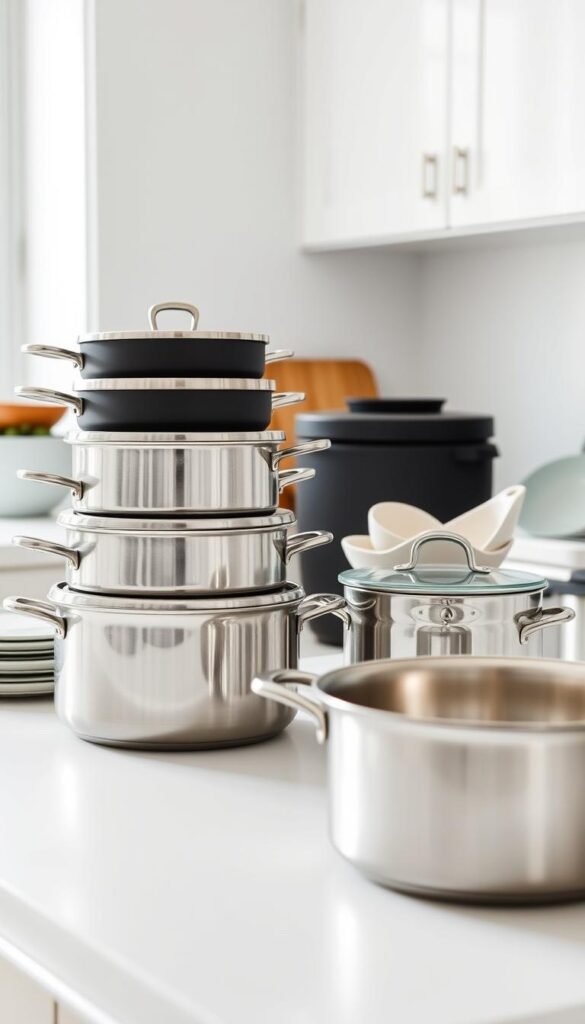
Simplifying Your Cookware Collection
A “Cookware Capsule” works like a wardrobe staple system: three saucepans (small, medium, large), two skillets (8″ and 12″), and one Dutch oven handle 90% of recipes. One home chef replaced 15 mismatched pots with this set—her cleanup time dropped by 40%.
Consider frequency of use when editing:
- Weekly users: Keep on open shelves or hanging racks
- Monthly tools: Store in lower cabinets with dividers
- Seasonal items: Rotate to high shelves or storage bins
Opting for Stackable and Nestable Items
Pyrex proves stackable design solves space puzzles. Their nesting bowls consolidate mixing tasks while glass construction avoids plastic odors. For lids, tension rods in deep drawers create vertical partitions—no more avalanche when searching for the 3-quart pot cover.
Other space-saving heroes:
- Collapsible colanders that flatten to 1″ thick
- Measuring cups that telescope together
- Baking sheets stored sideways like vinyl records
Glass vs. Plastic: Making the Switch
Material choices impact both organization and cooking performance. This comparison helps decide what belongs in your streamlined kitchen:
| Material | Thermal Retention | Storage Advantage | Best For |
|---|---|---|---|
| Cast Iron | Excellent | Stackable with cloth buffers | Slow-cooked dishes |
| Ceramic | Good | Nests with felt protectors | Even baking |
| Stainless Steel | Fair | Hangs on pegboards | Quick sautés |
For utensils, display wooden spoons in hand-thrown crocks—their organic textures add warmth. Convert cake stands into vertical plate organizers, proving function often hides in plain sight. When every item has a home, cooking becomes a joy rather than a juggle.
Maintaining a Minimalist Kitchen Daily
The rhythm of a minimalist kitchen flows through daily rituals, not just curated decor. Unlike one-time makeovers, lasting simplicity requires systems that blend seamlessly with day-to-day life. These practices transform upkeep from chore to calming ceremony.

Handwashing Dishes Throughout the Day
Let sudsy water become moving meditation. One designer swears by her “Dish Dance”—washing breakfast plates while listening to French jazz, drying dinnerware by twilight candlelight. Immediate cleaning prevents pileups and honors tools as functional art.
Try pairing:
- Morning espresso cups with news podcasts
- Lunch prep bowls with audiobook chapters
- Post-dinner pans with family gratitude sharing
The “One In, One Out” Rule
When a new item enters, another departs. This policy maintains equilibrium—whether replacing worn spatulas or adding holiday mugs. One Portland family keeps a donation bin in their pantry for instant edits.
Apply this to:
- Drawers: New measuring spoons? Remove duplicates
- Appliances: Air fryer arrival means toast oven exit
- Cookbooks: Latest acquisition = oldest unused donation
Regular Decluttering Sessions
Schedule monthly “Purge Parties” with mocktails and Motown playlists. Make it joyful—reward progress with new beeswax wraps or herb scissors. The five-minute nightly cabinet audit prevents accumulation before bed.
Rediscover existing tools during “No New Gadgets” months. That avocado slicer? Turns out it juliennes carrots beautifully. True organization means knowing what you already own.
Involving the Whole Family in Minimalism
Teaching children about simplicity creates lifelong habits of intentional living. Research shows kids mimic organizational behaviors by age three—like the Seattle toddler who uses just one Munchkin 360 cup instead of a cabinet full of sippy cups. When everyone contributes, minimalism becomes a shared family value rather than a top-down rule.
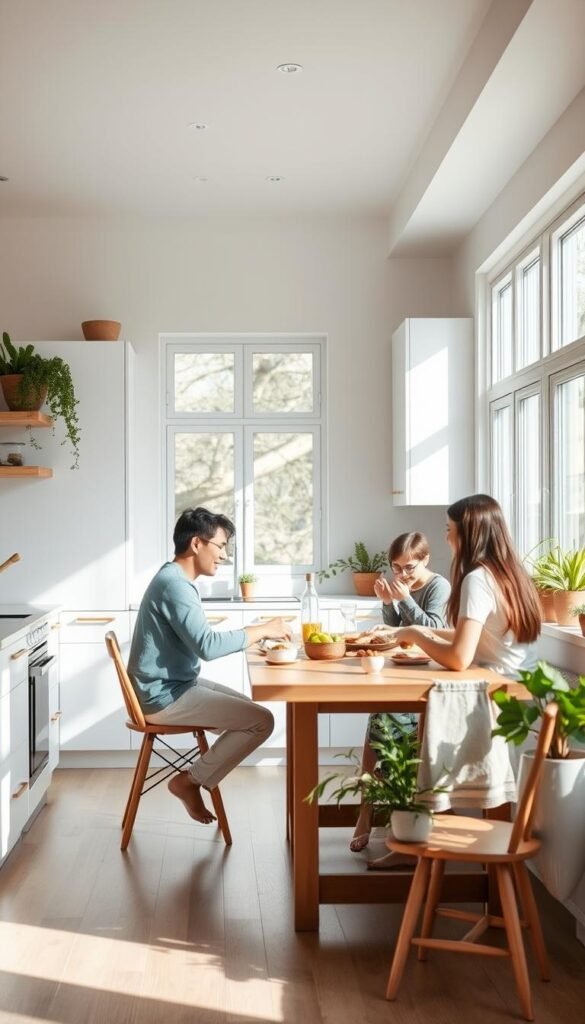
Teaching Kids About Minimalist Habits
Transform lessons into games. A “Treasure Hunt” for duplicate spatulas teaches editing skills, while color-coded bento boxes make lunch prep a creative exercise. Try these Montessori-inspired approaches:
- Tiny Chef Zones: Low drawers with toddler-safe utensils
- Visual Guides: Photo labels showing where items belong
- Rotation System: Seasonal swaps of art supplies and snack cups
Shared Responsibility for Kitchen Cleanliness
Assign age-appropriate zones using this framework:
| Age Group | Responsibility | Storage Solution |
|---|---|---|
| 3–6 years | Put away plastic dishes | Open bins at floor level |
| 7–12 years | Wipe counters and sort recycling | Pull-out step stools |
| Teens+ | Appliance maintenance | Designated charging stations |
Adapting Minimalism for Different Lifestyles
Grandma’s smooth maple rolling pin displayed beside modern measuring cups bridges generations. For coffee-loving teens, implement a mug quota—one personal cup plus two guest options. The key? Honor each person’s purpose in the space.
When a home embraces minimalism as a team, even the smallest hands learn that less clutter means more room for what truly matters—togetherness.
Conclusion
The true magic of a minimalist kitchen reveals itself in unexpected moments—like sunlight dancing across cleared countertops at golden hour. This space isn’t just functional; it’s a sanctuary where every item serves a purpose and sparks joy.
Begin your journey with a “First Seven-Day Purge”. Remove one unused tool daily. Notice how each release expands your culinary creativity. What remains? Only what you love and use.
Imagine a kitchen that feels like a hug after long days—a blend of intentional design and lived-in warmth. Your perfect version of simplicity is waiting. Start uncovering it today.
